Hijama, or cupping therapy, is an ancient healing practice that has gained significant popularity in recent years due to its various health benefits. This non-invasive therapeutic technique involves creating suction on the skin using special cups, promoting blood circulation, and supporting the body's natural healing processes. In this blog post, we will explore the best areas for Hijama Cupping Therapy in Dubai, how it works, its benefits, and answer some frequently asked questions.
What is Hijama Cupping Therapy?
Hijama, or cupping therapy, involves creating suction on the skin using cups, which can be made from glass, bamboo, silicone, or other materials. Practitioners apply these cups to specific areas of the body to promote healing and balance. The method combines traditional practices with modern wellness approaches, making it accessible and appealing to many who seek natural remedies for various ailments.
Benefits of Hijama Cupping Therapy
Promotes Circulation
One of the essential benefits of Hijama Cupping Therapy is enhancing blood circulation. The suction created by the cups drawn to the skin stimulates blood flow, potentially facilitating tissue repair and reducing muscle tension. Improved circulation helps deliver nutrients and oxygen to cells, promoting overall health and vitality.
Reduces Pain
Many individuals turn to cupping therapy for pain relief. The suction effect can target specific areas, providing relief from chronic pain conditions, muscle soreness, and joint discomfort. This therapy may benefit athletes or those with physically demanding lifestyles, helping them recover faster and maintain mobility.
Balances Energy
Hijama is deeply rooted in the principles of traditional medicine, which often emphasize the importance of energy balance within the body. Practitioners believe that cupping therapy can help remove stagnation or blockages, leading to enhanced energy flow and overall well-being. This technique aligns with holistic health practices, appealing to those interested in natural therapies.
Alleviates Stress and Anxiety
Cupping therapy can contribute to mental relaxation, often resulting in reduced stress and anxiety levels. The calming experience of the therapy may help individuals unwind and promote mental clarity. This aspect of Hijama can entirely resonate with Dubai's busy lifestyles, providing a much-needed reprieve from daily pressures.
Enhances Skin Health
Another noteworthy benefit is improved skin health. Cupping therapy can enhance blood circulation to the skin, contributing to a healthier appearance and potentially addressing various skin issues. Many people find that regular sessions can promote better skin tone and texture, making it a popular choice among those seeking aesthetic benefits.
Ideal Areas for Hijama Treatment
Back
The back is one of the most commonly treated areas in Hijama therapy. This region typically accumulates a lot of tension from daily activities and stress. By applying cups to the back, practitioners aim to relieve muscle tension while stimulating blood flow to this critical area of the body.
Shoulders
Another focal point for treatment is the shoulders. Due to their role in many physical activities and the common habit of poor posture, this area often experiences pain and discomfort. Cupping therapy on the shoulders can help alleviate this tension and release built-up stress, providing significant relief.
Neck
The neck is a sensitive area that can harbor tension and discomfort, especially in individuals who spend long hours in front of screens. Hijama therapy can effectively relieve neck pain and stiffness, promoting relaxation and improved mobility.
Abdomen
The abdomen is another area often treated in Hijama therapy. Some practitioners focus on this region to promote digestive health and address issues like bloating or discomfort. The suction applied can stimulate the digestive organs and support overall gut health.
Joints
Cupping therapy can be an excellent option for targeting specific joints like knees, elbows, and wrists. Treating these areas with cupping can help alleviate arthritis symptoms, joint pain, and discomfort due to overexertion. Cupping therapy on joints can aid in mobility and overall function.
Thighs and Legs
The thighs and legs are ideal areas for treatment, especially in athletes or those with active lifestyles. Cupping can help relieve soreness and tiredness, potentially enhancing performance and recovery. This region might also benefit from improved circulation and muscle relaxation, essential for physical activities.
Chest
Cupping therapy can also be applied to the chest area, particularly for individuals seeking respiratory benefits. This treatment can enhance blood flow and potentially promote better lung function. Breathing may feel more relaxed and deeper after such sessions, contributing to overall well-being.
FAQs
1. How often should I undergo Hijama cupping therapy?
The frequency of Hijama therapy sessions varies depending on individual needs and health conditions. It's generally advisable to consult with a practitioner to establish a suitable schedule based on your goals.
2. Can Hijama cupping therapy be combined with other treatments?
Yes, many practitioners integrate Hijama with other therapies, including acupuncture or physiotherapy, to enhance results. Discussing this with your practitioner will help determine the best approach.
3. Will I feel pain during the therapy session?
Most people describe the sensation as pressure or suction rather than pain. It's essential to communicate with your practitioner regarding any discomfort you may experience during the session.
4. Is there an ideal time of day for Hijama cupping therapy?
While there is no strict guideline on timing, many individuals prefer scheduling treatment sessions during the day when they can rest afterward, as relaxation can enhance the desired effects of therapy.
Conclusion
Hijama cupping therapy offers numerous potential benefits, making it a sought-after practice for those aiming for holistic health. Understanding the best areas for treatment can enhance the effectiveness of the therapy and ensure a rewarding experience. Whether it's for pain relief, stress reduction, or improving overall well-being, understanding how to engage with Hijama can lead to meaningful health improvements.





Comments